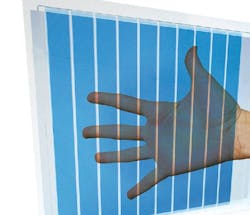Heliatek sets efficiency record for transparent organic solar cells
Organic solar film company Heliatek (Dresden, Germany) reached a new record in the conversion efficiency of transparent solar cells. The latest development allows transparency levels up to 40% with an efficiency of more than 7%. The company already holds the world record of 12% cell efficiency for opaque (non-transparent) organic solar cells.
RELATED ARTICLE: Transition metal oxides increase organic solar-cell power conversion
This lab development underscores the company’s strategy to supply its transparent HeliaFilm to glass manufacturers for both building integrated photovoltaics (BIPV) applications and car roofs. "The transparency of our products is at the core of our market approach. Our HeliaFilm [trade mark] is customized to meet our partners specific needs," said Thibaud Le Séguillon, Heliatek CEO. "We are a component supplier and this component is a film which can combine transparency and energy generation. This unique combination widens our market potential."
Both these application areas use tinted glass to reduce glare which can be done by applying a film, so changing the film to one that generates electricity as well is a drop-in for manufacturers. Using HeliaFilm in glass car roofs will not only generate energy, but will also allow the car manufacturers to claim Eco-innovation credits towards CO2 emission goals. Architectural glass panels and windows incorporating HeliaFilm enable electricity to be discretely generated on the outside envelope of a building. The technology generates electricity at low light levels, any orientation, and at high temperatures, which are conditions where conventional solar lose efficiency.
The latest generation of organic solar cells with a 40% light transparency reaches an efficiency record of 7.2%. The measurement follows standard testing conditions using a white background. Depending on the application, the balance between light throughput and electricity generation percentages can be adjusted.
Production of HeliaFilm is based on small molecules (oligomers) that are developed and synthesized at Heliatek. Oligomers are being deposited at low temperatures in a roll-to-roll vacuum process. One unique feature of the molecules used is their selective absorption of the solar spectrum, which allows different colors and transparency. The photoactive materials selectively convert sun light into electricity using transparent conductive layers at the front- and back-side of the solar cells.
SOURCE: Heliatek; http://www.heliatek.com/newscenter/latest_news/heliatek-erzielt-effizienzrekord-mit-40-transparenten-organischen-solarzellen/?lang=en

Gail Overton | Senior Editor (2004-2020)
Gail has more than 30 years of engineering, marketing, product management, and editorial experience in the photonics and optical communications industry. Before joining the staff at Laser Focus World in 2004, she held many product management and product marketing roles in the fiber-optics industry, most notably at Hughes (El Segundo, CA), GTE Labs (Waltham, MA), Corning (Corning, NY), Photon Kinetics (Beaverton, OR), and Newport Corporation (Irvine, CA). During her marketing career, Gail published articles in WDM Solutions and Sensors magazine and traveled internationally to conduct product and sales training. Gail received her BS degree in physics, with an emphasis in optics, from San Diego State University in San Diego, CA in May 1986.
